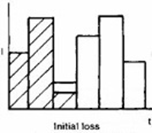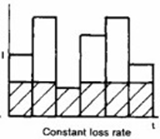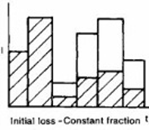| Product(s): |
SewerGEMS, CivilStorm |
| Version(s): |
08.11.XX.XX, 10.XX.XX.XX |
| Area: |
Layout and Data Input |
Problem
What is the theory behind the "Initial loss and constant fraction" loss method for catchment runoff, and when is it typically used?
Background
The Initial loss and constant fraction method is applicable to the Time-Area runoff method, Unit Hydrograph - SCS method and Unit Hydrograph - Generic method of runoff calculations.
With this method you need to specify the initial loss in units such as inches and the constant loss fraction in percentage. Then, the software will calculate the runoff depth based on that.
More reference material on this method can be found in Australian Rainfall and Runoff, book 5, chapter 3.
Solution
The proportional loss models assume that a fixed proportion or percentage of the rainfall is lost at each time step, after the initial loss has been satisfied, which means that losses throughout the event may vary depending on the temporal patterns of rainfall. In many of these models, the initial loss occurs in the beginning of the storm, prior to the commencement of surface runoff. It is assumed to be composed of interception losses, depression storage and infiltration before the soil surface is saturated;
There is typically a wide range of initial loss values observed for a catchment (Rahman et al., 2002; Phillips et al, 2014; Hill et al., 2014a). This variability reflects the importance of antecedent conditions but uncertainties in the estimation of the timing and distribution of the catchment average rainfall also contribute to the range of values. This potential variability in the initial loss value is an important consideration, particularly in application of historical storms to hydrological models.
Terms explained
Initial Loss
The total depth of rainfall that is considered to be lost:

This method comes from Australian Rainfall and Runoff, book 2, section 3.4.2, and is used in the UK.
Constant Fraction
Where loss (and hence runoff) is a constant fraction of rainfall in each time period. This is an extension of the runoff coefficient concept:

This method comes from Australian Rainfall and Runoff, book 2, section 3.4.2.
Constant Loss Rate
Where the rainfall excess is the residual left after a selected constant rate of infiltration capacity is satisfied:

This method comes from Australian Rainfall and Runoff, book 2, section 3.4.2.
Initial Loss and Constant Loss Rate
This is similar to (3.3) except that no runoff is assumed to occur until a given initial loss capacity has been satisfied, regardless of the rainfall rate. The continuing loss is at a constant rate.

This method comes from Australian Rainfall and Runoff, book 2, section 3.4.2.
A variation of this model that is sometimes recommended is to have an initial loss followed by a loss consisting of a constant fraction of the rainfall in the remaining time periods:

This method comes from Australian Rainfall and Runoff, book 2, section 3.4.2.
Supported hydrology runoff and loss methods
|
Constant
Loss Rate
|
Green &
Ampt
|
Horton
|
SCS CN
|
Initial loss &
Constant Fraction
|
Initial loss &
Constant Rate
|
ILSAX
Customized
|
RTK
Customized
|
None
|
|
Unit Hydrograph - Generic
|
Y
|
Y
|
Y
|
Y
|
Y
|
Y
|
|
|
Y
|
|
Unit Hydrograph - SCS
|
Y
|
Y
|
Y
|
Y
|
Y
|
Y
|
|
|
|
|
Time-Area
|
Y
|
Y
|
Y
|
Y
|
Y
|
Y
|
|
|
Y
|
|
EPA-SWMM (Kinematic)
|
|
Y
|
Y
|
Y
|
|
|
|
|
|
|
Unit Hydrograph - RTK
|
|
|
|
|
|
|
|
Y
|
|
|
ILSAX
|
|
|
|
|
|
|
Y
|
|
|
|
Modified Rational
|
|
|
|
|
|
|
|
|
|
|
User-Define-Hydrograph
|
|
|
|
|
|
|
|
|
|
Initial Loss and Constant Fraction method
You need to specify an initial loss value and a constant fraction, the model first applies the initial loss to the rainfall intensity curve and after the initial loss taken the model applies a constant fraction loss to get the excess rainfall intensity curve for runoff calculation. If one of the two data is zero then it means that only one of the loss types (either initial loss or the constant fraction loss) is applied. Therefore basically this loss method covers 3 types of losses:
- Initial Loss
- Constant Fraction Loss
- Initial Loss and Constant Fraction Loss combined
Computations
Here are designed calculation behaviours:
- Initial loss and constant fraction loss
User will input an initial loss value and a loss fraction value:
|
Cumulative rainfall depth (in)
User Input
|
Incremental depth
|
Initial loss and Fraction
User Input
|
Runoff Depth (Results)
|
|
0
|
0
|
0.014 and 0.5 (50%)
|
0
|
|
0.01
|
0.01
|
|
0
|
|
0.03
|
0.02
|
|
0.008
|
|
0.07
|
0.04
|
|
0.02
|
|
0.14
|
0.07
|
|
0.035
|
|
0.23
|
0.09
|
|
0.045
|
|
0.31
|
0.08
|
|
0.04
|
|
0.38
|
0.07
|
|
0.035
|
|
0.43
|
0.05
|
|
0.025
|
|
0.47
|
0.04
|
|
0.02
|
|
0.495
|
0.025
|
|
0.125
|
See Also